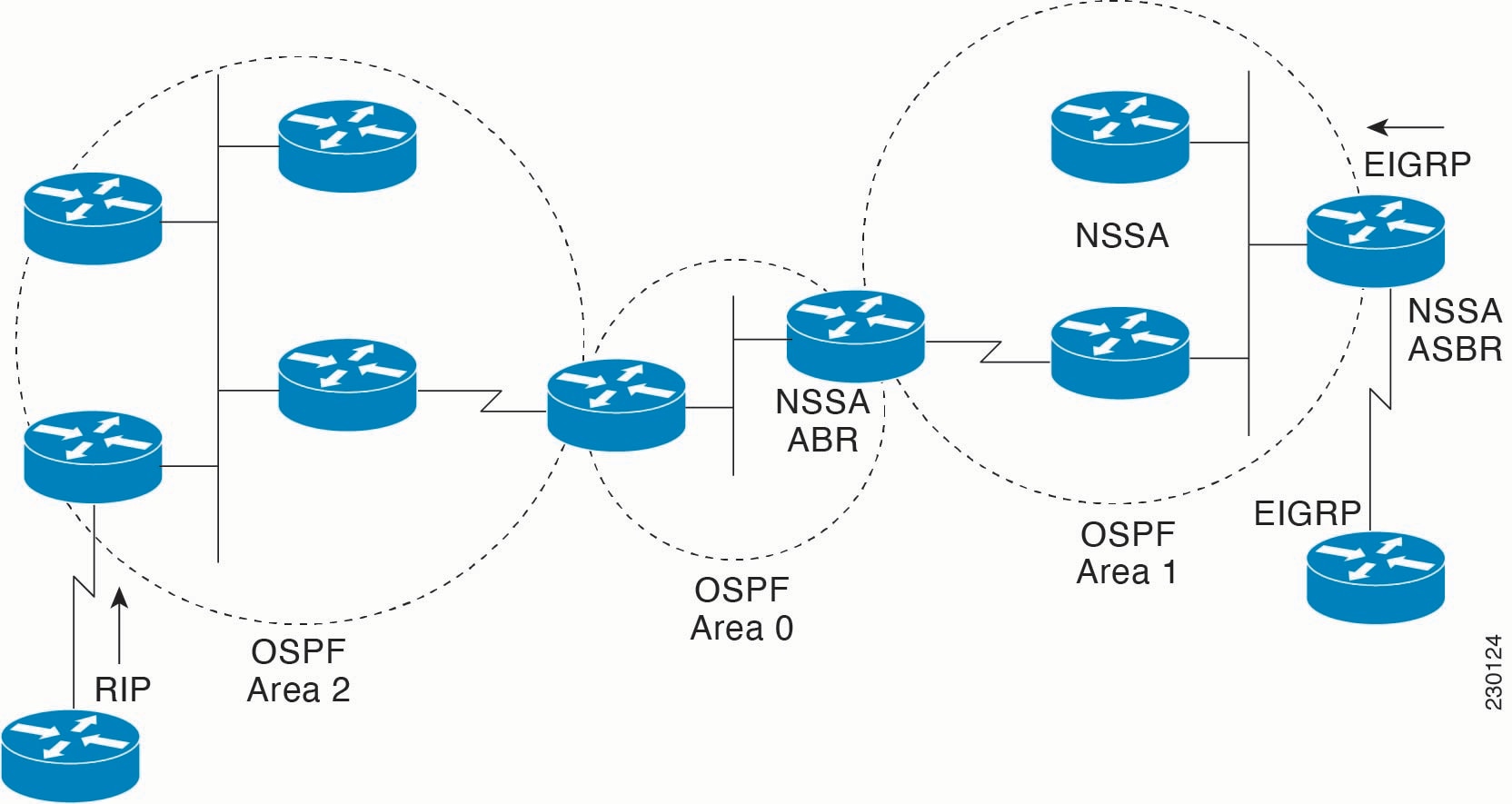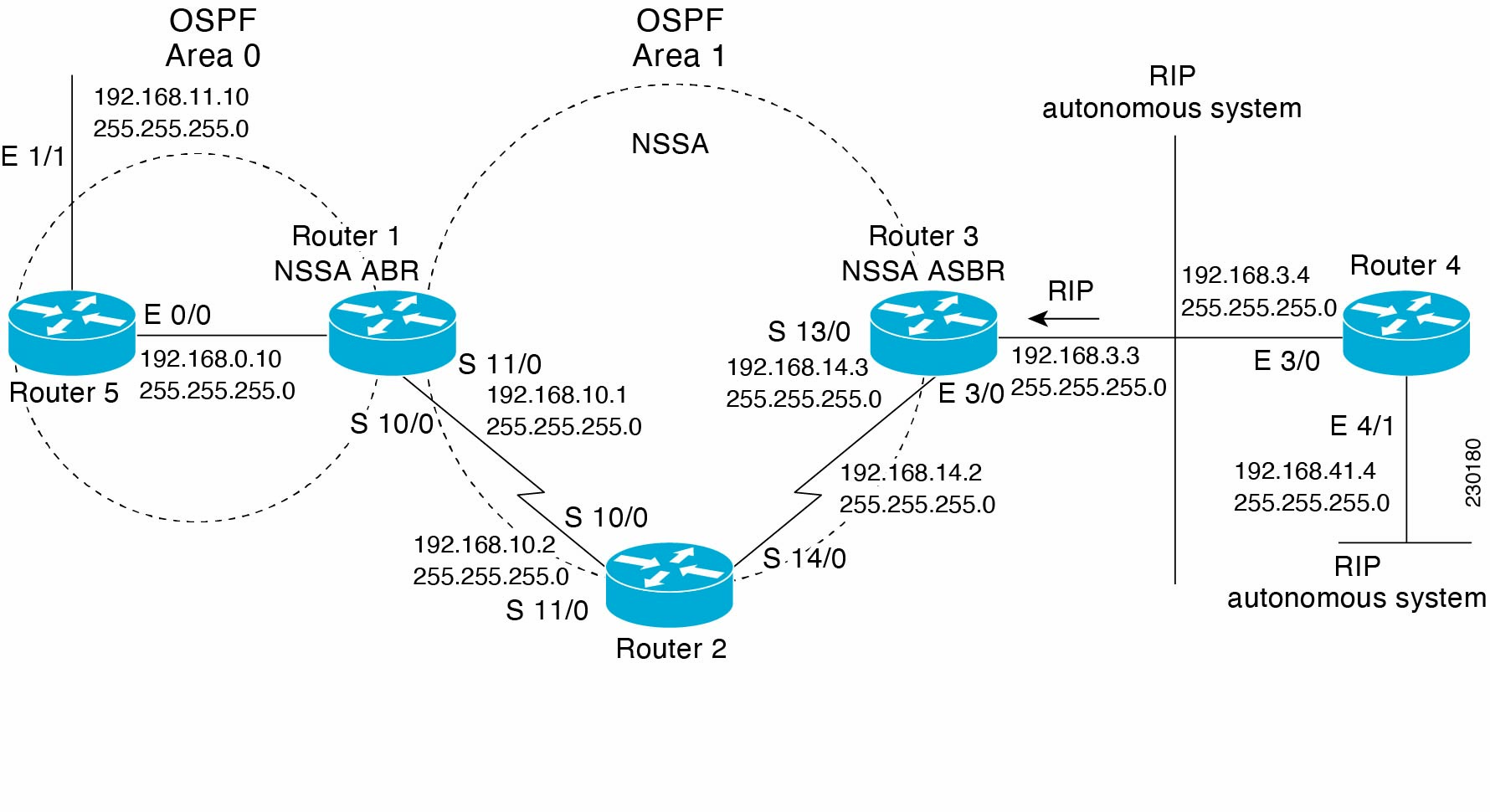The following is sample output from the show
ip
ospf command. The output displays that OSPF Area 1 is an NSSA area.
Device2#show ip ospf
Routing Process "ospf 1" with ID 10.1.0.2
Start time: 00:00:01.392, Time elapsed: 12:03:09.480
Supports only single TOS(TOS0) routes
Supports opaque LSA
Supports Link-local Signaling (LLS)
Supports area transit capability
Router is not originating router-LSAs with maximum metric
Initial SPF schedule delay 5000 msecs
Minimum hold time between two consecutive SPFs 10000 msecs
Maximum wait time between two consecutive SPFs 10000 msecs
Incremental-SPF disabled
Minimum LSA interval 5 secs
Minimum LSA arrival 1000 msecs
LSA group pacing timer 240 secs
Interface flood pacing timer 33 msecs
Retransmission pacing timer 66 msecs
Number of external LSA 0. Checksum Sum 0x000000
Number of opaque AS LSA 0. Checksum Sum 0x000000
Number of DCbitless external and opaque AS LSA 0
Number of DoNotAge external and opaque AS LSA 0
Number of areas in this router is 1. 0 normal 0 stub 1 nssa
Number of areas transit capable is 0
External flood list length 0
Area 1
Number of interfaces in this area is 2
! It is a NSSA area
Area has no authentication
SPF algorithm last executed 11:37:58.836 ago
SPF algorithm executed 3 times
Area ranges are
Number of LSA 7. Checksum Sum 0x045598
Number of opaque link LSA 0. Checksum Sum 0x000000
Number of DCbitless LSA 0
Number of indication LSA 0
Number of DoNotAge LSA 0
Flood list length 0
Device2#show ip ospf data
OSPF Router with ID (10.1.0.2) (Process ID 1)
Router Link States (Area 1)
Link ID ADV Router Age Seq# Checksum Link count
10.1.0.1 10.1.0.1 1990 0x80000016 0x00CBCB 2
10.1.0.2 10.1.0.2 1753 0x80000016 0x009371 4
10.1.0.3 10.1.0.3 1903 0x80000016 0x004149 2
Summary Net Link States (Area 1)
Link ID ADV Router Age Seq# Checksum
192.168.0.0 10.1.0.1 1990 0x80000017 0x00A605
192.168.11.0 10.1.0.1 1990 0x80000015 0x009503
Type-7 AS External Link States (Area 1)
Link ID ADV Router Age Seq# Checksum Tag
192.168.3.0 10.1.0.3 1903 0x80000015 0x00484F 0
192.168.41.0 10.1.0.3 1903 0x80000015 0x00A4CC 0
The following is sample output from the show
ip
ospf
database
data command. The output displays additional information about redistribution between Type 5 and Type 7 LSAs for routes that are
injected into the NSSA area and then flooded through the OSPF network.
Device2#show ip ospf database data
OSPF Router with ID (10.1.0.2) (Process ID 1)
Area 1 database summary
LSA Type Count Delete Maxage
Router 3 0 0
Network 0 0 0
Summary Net 2 0 0
Summary ASBR 0 0 0
Type-7 Ext 2 0 0
Prefixes redistributed in Type-7 0
Opaque Link 0 0 0
Opaque Area 0 0 0
Subtotal 7 0 0
Process 1 database summary
LSA Type Count Delete Maxage
Router 3 0 0
Network 0 0 0
Summary Net 2 0 0
Summary ASBR 0 0 0
Type-7 Ext 2 0 0
Opaque Link 0 0 0
Opaque Area 0 0 0
Type-5 Ext 0 0 0
Prefixes redistributed in Type-5 0
Opaque AS 0 0 0
Total 7 0 0
The following is sample output from the show
ip
ospf
database
nssa command. The output displays detailed information for Type 7 to Type 5 translations:
Device2#show ip ospf database nssa
OSPF Router with ID (10.1.0.2) (Process ID 1)
Type-7 AS External Link States (Area 1)
Routing Bit Set on this LSA
LS age: 1903
Options: (No TOS-capability, Type 7/5 translation, DC)
LS Type: AS External Link
Link State ID: 192.168.3.0 (External Network Number )
Advertising Router: 10.1.0.3
LS Seq Number: 80000015
Checksum: 0x484F
Length: 36
Network Mask: /24
Metric Type: 2 (Larger than any link state path)
TOS: 0
Metric: 20
Forward Address: 192.168.14.3
External Route Tag: 0
Routing Bit Set on this LSA
LS age: 1903
! Options: (No TOS-capability, Type 7/5 translation, DC)
LS Type: AS External Link
Link State ID: 192.168.41.0 (External Network Number )
Advertising Router: 10.1.0.3
LS Seq Number: 80000015
Checksum: 0xA4CC
Length: 36
Network Mask: /24
Metric Type: 2 (Larger than any link state path)
TOS: 0
Metric: 20
Forward Address: 192.168.14.3
External Route Tag: 0
The following sample output from the show
ip
ospf command displays that the device is acting as an ASBR and OSPF Area 1 is configured as an NSSA area:
Device3#show ip ospf
Routing Process "ospf 1" with ID 10.1.0.3
Start time: 00:00:01.392, Time elapsed: 12:02:34.572
Supports only single TOS(TOS0) routes
Supports opaque LSA
Supports Link-local Signaling (LLS)
Supports area transit capability
!It is an autonomous system boundary router
Redistributing External Routes from,
rip, includes subnets in redistribution
Router is not originating router-LSAs with maximum metric
Initial SPF schedule delay 5000 msecs
Minimum hold time between two consecutive SPFs 10000 msecs
Maximum wait time between two consecutive SPFs 10000 msecs
Incremental-SPF disabled
Minimum LSA interval 5 secs
Minimum LSA arrival 1000 msecs
LSA group pacing timer 240 secs
Interface flood pacing timer 33 msecs
Retransmission pacing timer 66 msecs
Number of external LSA 0. Checksum Sum 0x000000
Number of opaque AS LSA 0. Checksum Sum 0x000000
Number of DCbitless external and opaque AS LSA 0
Number of DoNotAge external and opaque AS LSA 0
Number of areas in this router is 1. 0 normal 0 stub 1 nssa
Number of areas transit capable is 0
External flood list length 0
Area 1
Number of interfaces in this area is 1
! It is a NSSA area
Area has no authentication
SPF algorithm last executed 11:38:13.368 ago
SPF algorithm executed 3 times
Area ranges are
Number of LSA 7. Checksum Sum 0x050CF7
Number of opaque link LSA 0. Checksum Sum 0x000000
Number of DCbitless LSA 0
Number of indication LSA 0
Number of DoNotAge LSA 0
Flood list length 0
The table below describes the significant fields shown in the show
ip
ospf command output.
Table 1. show ip ospf Field Descriptions
|
Field
|
Description
|
|
Routing process "ospf 1" with ID 10.1.0.3
|
Process ID and OSPF router ID.
|
|
Supports ...
|
Number of types of service supported (Type 0 only).
|
|
Summary Link update interval
|
Specifies summary update interval in hours:minutes:seconds, and time until next update.
|
|
External Link update interval
|
Specifies external update interval in hours:minutes:seconds, and time until next update.
|
|
Redistributing External Routes from
|
Lists of redistributed routes, by protocol.
|
|
SPF calculations
|
Lists start, hold, and maximum wait interval values in milliseconds.
|
|
Number of areas
|
Number of areas in router, area addresses, and so on.
|
|
SPF algorithm last executed
|
Shows the last time an SPF calculation was performed in response to topology change event records.
|
|
Link State Update Interval
|
Specifies router and network link-state update interval in hours:minutes:seconds, and time until next update.
|
|
Link State Age Interval
|
Specifies max-aged update deletion interval, and time until next database cleanup, in hours:minutes:seconds.
|
Example: OSPF NSSA Area with RFC 3101 Disabled and RFC 1587 Active
In the following example, the output for the show
ip
ospf and show
ip
ospf
database
nssa commands shows an Open Shortest Path First Not-So-Stubby Area (OSPF NSSA) area where RFC 3101 is disabled, RFC 1587 is active,
and an NSSA Area Border Router (ABR) device is configured as a forced NSSA LSA translator. If RFC 3101 is disabled, the forced
NSSA LSA translator remains inactive.
Device#show ip ospf
Routing Process "ospf 1" with ID 10.0.2.1
Start time: 00:00:25.512, Time elapsed: 00:01:02.200
Supports only single TOS(TOS0) routes
Supports opaque LSA
Supports Link-local Signaling (LLS)
Supports area transit capability
Supports NSSA (compatible with RFC 1587)
Event-log enabled, Maximum number of events: 1000, Mode: cyclic
Router is not originating router-LSAs with maximum metric
Initial SPF schedule delay 5000 msecs
Minimum hold time between two consecutive SPFs 10000 msecs
Maximum wait time between two consecutive SPFs 10000 msecs
Incremental-SPF disabled
Minimum LSA interval 5 secs
Minimum LSA arrival 1000 msecs
LSA group pacing timer 240 secs
Interface flood pacing timer 33 msecs
Retransmission pacing timer 66 msecs
Number of external LSA 0. Checksum Sum 0x000000
Number of opaque AS LSA 0. Checksum Sum 0x000000
Number of DCbitless external and opaque AS LSA 0
Number of DoNotAge external and opaque AS LSA 0
Number of areas in this router is 1. 0 normal 0 stub 1 nssa
Number of areas transit capable is 0
External flood list length 0
IETF NSF helper support enabled
Cisco NSF helper support enabled
Reference bandwidth unit is 100 mbps
Area 1
Number of interfaces in this area is 1
It is a NSSA area
Configured to translate Type-7 LSAs, inactive (RFC3101 support
disabled)
Area has no authentication
SPF algorithm last executed 00:00:07.160 ago
SPF algorithm executed 3 times
Area ranges are
Number of LSA 3. Checksum Sum 0x0245F0
Number of opaque link LSA 0. Checksum Sum 0x000000
Number of DCbitless LSA 0
Number of indication LSA 0
Number of DoNotAge LSA 0
Flood list length 0
The table below describes the significant fields shown in the show
ip
ospf command output.
Table 2. show ip ospf Field Descriptions
|
Field
|
Description
|
|
Supports NSSA (compatible with RFC 1587)
|
Specifies that RFC 1587 is active or that the OSPF NSSA area is RFC 1587 compatible.
|
|
Configured to translate Type-7 LSAs, inactive (RFC3101 support disabled)
|
Specifies that OSPF NSSA area has an ABR device configured to act as a forced translator of Type 7 LSAs. However, it is inactive
because RFC 3101 is disabled
|
Device2#show ip ospf database nssa
Router Link States (Area 1)
LS age: 28
Options: (No TOS-capability, DC)
LS Type: Router Links
Link State ID: 10.0.2.1
Advertising Router: 10.0.2.1
LS Seq Number: 80000004
Checksum: 0x5CA2
Length: 36
Area Border Router
AS Boundary Router
Unconditional NSSA translator
Number of Links: 1
Link connected to: a Stub Network
(Link ID) Network/subnet number: 192.0.2.5
(Link Data) Network Mask: 255.255.255.0
Number of MTID metrics: 0
TOS 0 Metrics: 10
The table below describes the significant fields shown in the show
ip
ospf
database nssa command output.
Table 3. show ip ospf database nssa Field Description
|
Field
|
Description
|
|
Unconditional NSSA translator
|
Specifies that NSSA ASBR device is a forced NSSA LSA translator
|


 Feedback
Feedback